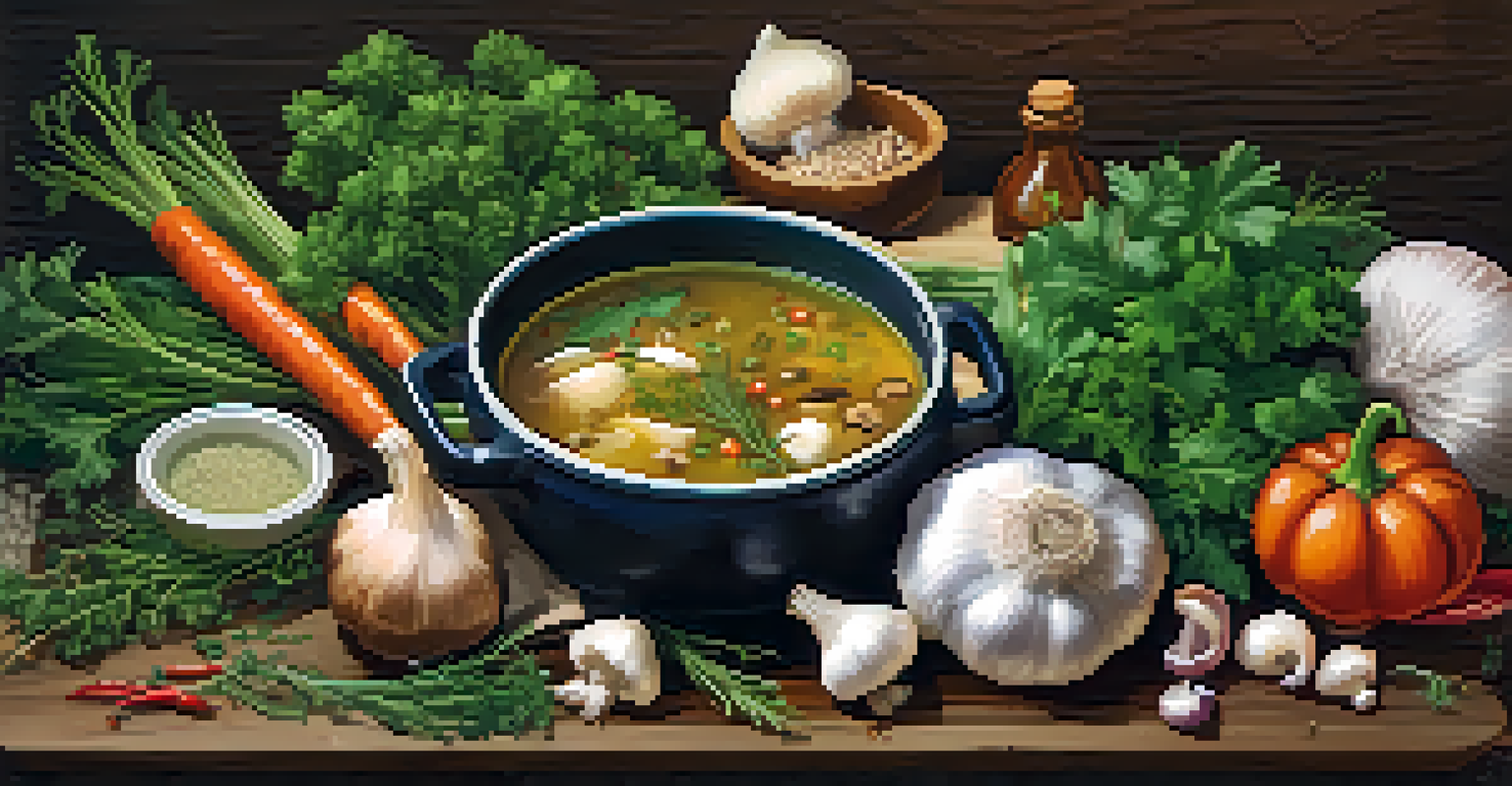Crafting Flavorful Broths: Techniques for Nutritious Soups

Understanding the Basics of Broth Making
Broth forms the backbone of many delicious soups and stews, providing depth and flavor. At its core, broth is a liquid made by simmering meat, bones, or vegetables in water. This gentle cooking process extracts flavors and nutrients, creating a rich, aromatic base that's perfect for countless recipes.
Good broth will resurrect the dead.
The beauty of broth is its versatility; you can use virtually any combination of ingredients to suit your taste or dietary needs. For instance, chicken bones might yield a comforting chicken broth, while a mix of carrots, celery, and onions creates a robust vegetable broth. Understanding the basics allows you to tailor your broth to complement the final dish.
Moreover, making broth at home is not only cost-effective but also healthier than store-bought options, often laden with preservatives. By crafting your own, you control the ingredients and can adjust flavors to your preference, enhancing both nutrition and taste.
Choosing the Right Ingredients for Flavor
The key to a flavorful broth lies in selecting quality ingredients. Fresh, organic vegetables and high-quality meat or bones provide the best flavors and nutrients. Think of ingredients as the colors on a painter's palette; the more vibrant and fresh they are, the more vivid your broth will be.

For a classic chicken broth, ingredients like onion, garlic, and herbs such as thyme or parsley work wonders. On the other hand, for a heartier beef broth, consider adding roasted bones and aromatic vegetables to build a deeper flavor profile. Don’t shy away from experimenting with spices and herbs; they can elevate your broth to new heights.
Broth Basics: A Flavorful Foundation
Broth is a versatile base for soups and stews, crafted by simmering meat, bones, or vegetables to extract rich flavors and nutrients.
Incorporating umami-rich ingredients like mushrooms, seaweed, or even a splash of soy sauce can enhance the depth of your broth. This not only adds layers of flavor but also makes your soup more satisfying and enjoyable to eat.
The Art of Simmering: Time and Temperature
Simmering is an essential technique in broth-making that ensures flavors meld beautifully without becoming cloudy or bitter. The ideal temperature for simmering is just below boiling, which allows ingredients to release their flavors slowly and steadily. Think of it as a gentle hug for your ingredients, coaxing out their best qualities.
Cooking is like love. It should be entered into with abandon or not at all.
Generally, a good broth needs time to develop its full flavor, with simmering times varying based on the ingredients. For chicken broth, aim for 1-2 hours, while a beef broth may need 4-6 hours to extract maximum flavor from the bones. Patience is key here; the longer you simmer, the richer the broth becomes.
Be cautious not to let the broth boil vigorously, as this can emulsify the fats and lead to a greasy texture. Instead, keep a watchful eye and adjust the heat as needed, ensuring a consistent simmer that will yield a clear, delicious broth.
Straining and Storing Your Broth Properly
Once your broth has simmered to perfection, it's time to strain it for a smooth finish. Using a fine mesh strainer or cheesecloth, carefully pour the broth to separate the liquid from the solids. This step is crucial for achieving a clear broth that’s visually appealing and pleasant to consume.
After straining, let the broth cool before transferring it to storage containers. Glass jars or BPA-free plastic containers work well for this purpose. For added convenience, consider portioning it into smaller containers, making it easy to grab a quick serving for future meals.
Choosing Quality Ingredients Matters
Selecting fresh, high-quality ingredients elevates the flavor and nutritional value of your broth, making each bowl a delightful experience.
Properly stored, homemade broth can last in the refrigerator for up to a week or be frozen for several months. Just remember to leave some space in the container for expansion when freezing. This way, you’ll always have a flavorful base ready to elevate your soups and stews.
Enhancing Broth with Aromatics and Seasoning
Aromatics play a crucial role in transforming a simple broth into something extraordinary. Ingredients like onions, garlic, and ginger not only add flavor but also contribute to the broth's nutritional profile. Think of these aromatics as the musicians in an orchestra, each adding their unique sound to create a harmonious blend.
Don’t hesitate to season your broth generously with salt, but remember to adjust seasoning after it’s been reduced or combined with other ingredients. A well-seasoned broth acts as a flavor enhancer for your final dish, ensuring every bite is delicious and satisfying.
Herbs also deserve a spotlight in your broth-making journey; add them towards the end of the simmering process for a fresh, vibrant note. Fresh herbs like basil, cilantro, or dill can transform your broth, making it a delightful base for soups or sauces.
Creative Variations: Broths from Around the World
Broth-making is a universal practice, and every culture has its own unique take on this culinary staple. For instance, in Asian cuisine, miso broth serves as a flavorful base for ramen, while Thai tom yum is known for its aromatic spices and herbs. Exploring these global variations can inspire creativity in your own kitchen.
Mediterranean broths often incorporate ingredients like olives, lemon, and saffron, resulting in a fresh and zesty flavor profile. These unique ingredients not only diversify the flavor but also introduce new nutritional elements, making your meals more exciting and healthy.
Simmer Slowly for Optimal Flavor
A gentle simmer allows flavors to meld beautifully, with longer cooking times enhancing the richness and clarity of your broth.
By trying out different regional broths, you broaden your culinary horizons and discover new favorite flavors. Don't hesitate to mix and match techniques and ingredients from various cuisines to create a broth that's truly your own.
Using Broth as a Foundation for Nutrient-Rich Soups
Once you've perfected your broth, the real fun begins! A hearty, nutritious soup can be created by simply adding ingredients like vegetables, legumes, and grains to your homemade broth. This not only enhances the flavor but also boosts the nutritional value of your meal, turning a simple broth into a complete dish.
For example, adding lentils and diced tomatoes to your vegetable broth creates a filling soup that's both hearty and healthy. Similarly, tossing in noodles or rice with leafy greens can yield a comforting meal that warms you from the inside out.

The versatility of broth means you can adapt your soups based on seasonal ingredients or personal preferences. This makes it easy to create a variety of delicious, nutritious soups throughout the year, ensuring you always have something tasty to enjoy.